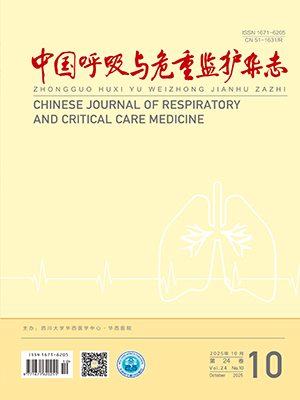Objective To explore the predictive value of transthoracic electrical impedance tomography (EIT) for outcome of weaning patients from mechanical ventilation. Methods Forty invasive mechanical ventilation adult patients who underwent spontaneous breathing test (SBT) from May 2022 to August 2022 were enrolled. The patients were divided into a successful weaning group (n=28) and a failed weaning group (n=12) based on whether invasive mechanical ventilation was required within 48 hours after weaning. EIT data were collected from both groups on the first day of mechanical ventilation, before SBT, 10 minutes after SBT, and 30 minutes after SBT. The EIT parameters were compared between two groups, including the absolute value of mean end expiratory lung impedance variation (Mean △EELI) to tidal volume ratio, percentage variation of local compliance change (|Δ(CW-CL)|), inflation time difference (TSA), standard deviation of regional ventilation delay (SDRVD), abdominal to back impedance ratio (IR), and rapid shallow breathing index (RSBI) calculated by EIT, at different time points of SBT, and the predictive value of each EIT parameter were evaluated for weaning. Results The parameters of SDRVD value, RSBIEIT value, and TSA value in the successful weaning group were significantly lower compared with the failed weaning group (P<0.05); during SBT process, the predictive value of the SDRVD for weaning was the highest compared with other EIT parameters (AUC=0.978, 95%CI 0.940-1.016; P<0.001). When the SDRVD value, less than 0.845, was as the critical value and the sensitivity was 0.917 and the specificity was 0.929; the RSBIEIT value for prediction weaning also was high (AUC=0.960, 95%CI 0.904-1.015; P<0.001). When RSBIEIT, less than 0.893, was used as the critical value, and its sensitivity and specificity was 1.000 and 0.893, respectively (P<0.05). The TSA value and |Δ(CW-CL)| predicted weaning value are relatively small, and further research is needed on whether IR and |Mean ∆EELI/VT| can guide weaning. Conclusions The EIT parameters SDRVD and RSBIEIT can effectively predict the weaning outcomes of mechanically ventilated adult patients and have good clinical application value.
Citation:
WANG Meiling, DING Yuru, PENG Liangshan, LUO Qiong, WANG Qiaosheng. Predictive value of transthoracic electrical impedance tomography in weaning adult patients from mechanical ventilation. Chinese Journal of Respiratory and Critical Care Medicine, 2025, 24(7): 499-506. doi: 10.7507/1671-6205.202411003
Copy
Copyright © the editorial department of Chinese Journal of Respiratory and Critical Care Medicine of West China Medical Publisher. All rights reserved
| 1. |
|
| 2. |
|
| 3. |
|
| 4. |
|
| 5. |
|
| 6. |
|
| 7. |
|
| 8. |
|
| 9. |
|
| 10. |
|
| 11. |
|
| 12. |
|
| 13. |
|
| 14. |
|
| 15. |
|
| 16. |
|
| 17. |
|
| 18. |
|
| 19. |
|
| 20. |
|
| 21. |
|
| 22. |
|
| 23. |
Heunks LM, van der Hoeven JG. Clinical review: the ABC of weaning failure--a structured approach. Crit Car, 2010;14(6): 245.
|
| 24. |
|
| 25. |
|
- 1.
- 2.
- 3.
- 4.
- 5.
- 6.
- 7.
- 8.
- 9.
- 10.
- 11.
- 12.
- 13.
- 14.
- 15.
- 16.
- 17.
- 18.
- 19.
- 20.
- 21.
- 22.
- 23. Heunks LM, van der Hoeven JG. Clinical review: the ABC of weaning failure--a structured approach. Crit Car, 2010;14(6): 245.
- 24.
- 25.




